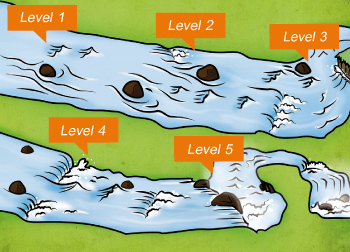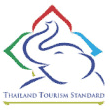
![]() hite-water rafting is one of the leading forms of holiday activities in Thailand; it is an adventure in the wilderness, taking participants to remote places that can only be reached by highways of water. If you are fascinated by rivers - by the call to find what lies around the next bend of moving water - then this door is open for those who take on the challenge of running rivers. Whether you are a first-time rafter or a seasoned veteran of white-water rivers, it is a truly exciting time to be a river runner and a witness to the power and splendour of the river’s mighty rapids.
hite-water rafting is one of the leading forms of holiday activities in Thailand; it is an adventure in the wilderness, taking participants to remote places that can only be reached by highways of water. If you are fascinated by rivers - by the call to find what lies around the next bend of moving water - then this door is open for those who take on the challenge of running rivers. Whether you are a first-time rafter or a seasoned veteran of white-water rivers, it is a truly exciting time to be a river runner and a witness to the power and splendour of the river’s mighty rapids.
Like most outdoor sports, rafting in general has become safer over the years. Expertise in the sport has increased, as well as a rescue team, and equipment has become more specialised and increased in quality. At the same time, rafting must balance its use of nature with the conservation of rivers as a natural resource and habitat. Because of these issues, some rivers now have regulations restricting the annual and daily operating times or numbers of rafters.

International Grading System White-water Classification

Level 1: Easy
Fast moving water with ripples and small waves. Few obstructions, all obvious and easily missed with little training. Risk to swimmers is slight; self-rescue is easy.
Level 2: Novice
Straightforward rapids with wide, clear channels which are evident without scouting. Occasional manoeuvering may be required, but rocks and medium-sized waves are easily missed by trained paddlers. Swimmers are seldom injured and group assistance, while helpful, is seldom needed.
Level 3: Intermediate
Waves numerous, high, irregular; rocks; eddies; rapids with passages clear though narrow, requiring expertise in manoeuvering; scouting usually needed. It also requires good operator and boat.
Level 4: Advanced
Long, intense, powerful but predictable rapids; waves high, irregular; dangerous rocks; boiling eddies; best passages difficult to scout; scouting mandatory first time; powerful and precise manoeuvering required. Demands expert boatman and excellent boat and good quality equipment.
Level 5: Expert
Long distance obstructed or violent rapids which expose paddlers to above average danger. Drops may contain large unavoidable waves or holes. Rapids may continue for long distances between pools, requiring a high level of fitness. Scouting is a must.



Thailand Tourism Standards for White-water Rafting
To ensure the safety of tourists who choose to participate in White-water rafting, the Department of Tourism Development, Ministry of Tourism and Sports, has issued the Thailand’s Tourism Standards for White-water Rafting to provide guidelines on the sport with emphasis on safety for participants. For more information, visit http://www.tourism.go.th
Best Practice of White-water Rafting
- There are some useful tips for river runners;
- If you plan to do rafting on your own, please contact local area officers for permission before entering the areas; for example, a national park or the Royal Forest Department.
- If you plan to do rafting with travel agents, a travel company with the white-water rafting operator certificate is highly recommended.
- Get to know the river and stream, especially the area with rapids with difficulty levels 3-5. Learn how to read hand signals.
- Before getting started, check your raft’s condition carefully.
- It is good to know each member’s skills (swimming, rafting and language) in order to set the proper seating position on a boat.
- Make sure you wear safety gear at all times.
- Bring only necessary items with you and put them in a dry bag.
- You should wear light, fitting and anti-water absorbing clothes. Bringing spare clothes and shoes is recommended. No flip flops. During the winter season, a jacket can keep you warmer.
- Follow instructions given by your boat captain.
- Prepare yourself well for both physical and mental strengths.
Where to do White-water Rafting
| Place | Province | Season To Visit | Level | Time | |
|---|---|---|---|---|---|
| 1 | Pai River | Mae Hong Son | All year long | 3-4 | 6 hours |
| 2 | Mae Taeng River | Chiang Mai | All year long | 2-5 | 2.5 hours |
| 3 | Nam Wa River | Nan | May - Oct Nov - Feb |
3-5 3-4 |
3 hours to 3 days |
| 4 | San River | Loei | Jun - Oct | 1-5 |
3 hours |
| 5 | Khek River | Phitsanulok | May - Oct Nov - Feb Mar - May |
4-5 3-4 2-3 |
2-3 hours |
| 6 | Umphang Khi | Tak |
Nov - May | 3-4 | 4 hours |
| 7 | Namtok Thi Lo Re | Tak |
Nov - May |
3-4 | 6 hours |
| 8 | Mae Rewa Creek | Nakhon Sawan | All year long |
2-3 |
1.5 hours |
| 9 | Phu Ko | Saraburi | Oct - Jan | 1-3 |
1.5 hours |
| 10 | Nakhon Nayok River | Nakhon Nayok | Jul - Oct | 2-3 |
2 hours |
| 11 | Kaeng Hin Phoeng | Prachin Buri | Jun - Oct |
3-5 | 2 hours |
| 12 | Khlong Pong Nam Ron | Chanthaburi | Jun - Nov |
1-3 | 2-3 hours |
| 13 | Phato | Chumphon | All year long | 3-4 | 3 hours |
| 14 | Ton Pariwat | Phang-nga | All year long | 2-4 | 2 hours |
| 15 | Khlong Klai | Nakhon Si Thammarat | All year long | 1-3 | 3 hours |
| 16 | Nan Mot Daeng | Phatthalung | All year long | 1-3 | 2 hours |
| 17 | Khlong Lam Lon - Wang Sai Thong | Satun | All year long | 1-3 | 2 hours |



